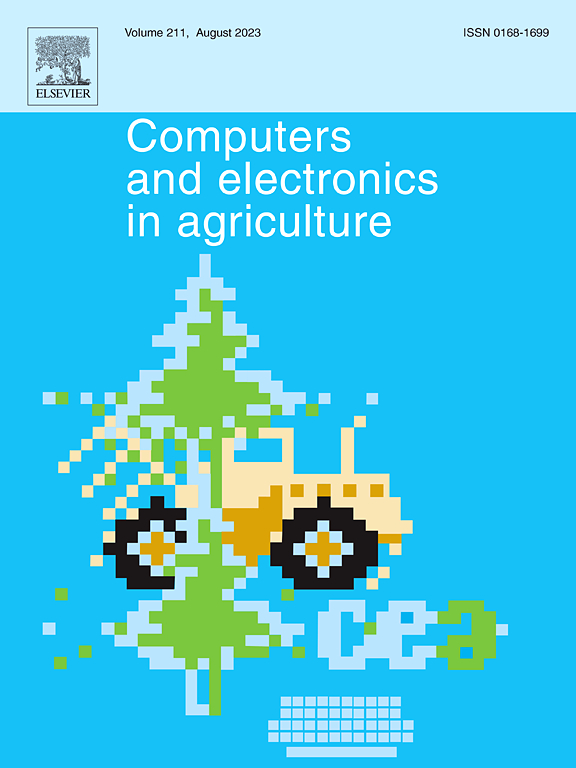不同温度下奶牛场浆料中氮磷近红外光谱评价模型的构建与优化
IF 8.9
1区 农林科学
Q1 AGRICULTURE, MULTIDISCIPLINARY
引用次数: 0
摘要
近红外光谱(NIRS)被广泛应用于畜牧业浆料中总氮(TN)和总磷(TP)的检测。然而,在实际测量中,温度会干扰近红外光谱,影响模型的鲁棒性。因此,我们采用温度全局模型(TG)、外部参数正交化(EPO)和遗传算法(GA)三种方法来减轻温度对模型性能的影响。我们从中国天津一家有代表性的奶牛场收集了365份浆液样本。在实验室进行温度梯度实验,在0-40℃范围内设置5℃区间。结果表明,温度对TN模型的影响大于TP模型,且温度越高影响越大。与未优化TN模型相比,TG、EPO和GA优化TN模型的RMSEP分别降低了- 8%至32%、- 14%至35%和- 1%至33%。对于未优化的TP模型,TG、EPO和GA优化的TP模型的RMSEP分别下降了- 27% ~ 16%、- 33% ~ 13%和- 24% ~ 9%。总氮的最佳提取方法为GA法(RMSEP = 168 mg/L),总磷的最佳提取方法为EPO过滤法(RMSEP = 69 mg/L)。快速准确预测田间变温条件下料浆中全氮、全磷含量,为优化料浆管理、提高养分利用效率、促进资源可持续循环提供关键技术支持。本文章由计算机程序翻译,如有差异,请以英文原文为准。

Construction and optimization of a near-infrared spectroscopic model for the assessment of nitrogen and phosphorus in dairy farm slurry under different temperatures
Near-infrared spectroscopy (NIRS) was widely used for total nitrogen (TN) and total phosphorus (TP) detection in the slurry of animal farming. However, temperature could interfere with NIRS in practical measurements, affecting the robustness of models. Therefore, we employed three methods of temperature global model (TG), external parameter orthogonalization (EPO) and genetic algorithms (GA) to mitigate the impact of temperature on model performance. We collected 365 slurry samples from a representative dairy farm in Tianjin, China. Temperature gradient experiments were implemented in the lab, setting 5 ℃ intervals within the range of 0–40 ℃. It was found that temperature had a greater influence on the TN model compared to the TP model, with higher temperature occurring greater effects. Compared to the unoptimized TN model, the TG, EPO, and GA optimized models of TN showed reductions in RMSEP ranging from −8% to 32 %, −14 % to 35 %, and −1% to 33 %, respectively. And for the unoptimized TP model, the TG, EPO, and GA optimized models of TP exhibited a decrease in RMSEP ranging from −27 % to 16 %, −33 % to 13 %, and −24 % to 9 %, respectively. The optimal method for TN was the GA method (RMSEP = 168 mg/L), while the optimal method for TP was EPO filtering (RMSEP = 69 mg/L). The ability to rapidly and accurately predict TN and TP contents in slurry under field variable temperatures offer critical technical support for optimizing slurry management, enhancing nutrient utilization efficiency, and promoting sustainable resource recycling.
求助全文
通过发布文献求助,成功后即可免费获取论文全文。
去求助
来源期刊

Computers and Electronics in Agriculture
工程技术-计算机:跨学科应用
CiteScore
15.30
自引率
14.50%
发文量
800
审稿时长
62 days
期刊介绍:
Computers and Electronics in Agriculture provides international coverage of advancements in computer hardware, software, electronic instrumentation, and control systems applied to agricultural challenges. Encompassing agronomy, horticulture, forestry, aquaculture, and animal farming, the journal publishes original papers, reviews, and applications notes. It explores the use of computers and electronics in plant or animal agricultural production, covering topics like agricultural soils, water, pests, controlled environments, and waste. The scope extends to on-farm post-harvest operations and relevant technologies, including artificial intelligence, sensors, machine vision, robotics, networking, and simulation modeling. Its companion journal, Smart Agricultural Technology, continues the focus on smart applications in production agriculture.
 求助内容:
求助内容: 应助结果提醒方式:
应助结果提醒方式:


